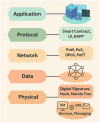Blockchain enabled collective and combined deep learning framework for COVID19 diagnosis
- PMID: 40360521
- PMCID: PMC12075842
- DOI: 10.1038/s41598-025-00252-7
Blockchain enabled collective and combined deep learning framework for COVID19 diagnosis
Abstract
The rapid spread of SARS-CoV-2 has highlighted the need for intelligent methodologies in COVID-19 diagnosis. Clinicians face significant challenges due to the virus's fast transmission rate and the lack of reliable diagnostic tools. Although artificial intelligence (AI) has improved image processing, conventional approaches still rely on centralized data storage and training. This reliance increases complexity and raises privacy concerns, which hinder global data exchange. Therefore, it is essential to develop collaborative models that balance accuracy with privacy protection. This research presents a novel framework that combines blockchain technology with a combined learning paradigm to ensure secure data distribution and reduced complexity. The proposed Combined Learning Collective Deep Learning Blockchain Model (CLCD-Block) aggregates data from multiple institutions and leverages a hybrid capsule learning network for accurate predictions. Extensive testing with lung CT images demonstrates that the model outperforms existing models, achieving an accuracy exceeding 97%. Specifically, on four benchmark datasets, CLCD-Block achieved up to 98.79% Precision, 98.84% Recall, 98.79% Specificity, 98.81% F1-Score, and 98.71% Accuracy, showcasing its superior diagnostic capability. Designed for COVID-19 diagnosis, the CLCD-Block framework is adaptable to other applications, integrating AI, decentralized training, privacy protection, and secure blockchain collaboration. It addresses challenges in diagnosing chronic diseases, facilitates cross-institutional research and monitors infectious outbreaks. Future work will focus on enhancing scalability, optimizing real-time performance and adapting the model for broader healthcare datasets.
Keywords: Blockchain technology; Combined learning paradigm; Diagnostic techniques; Ensemble learning; Hybrid capsule learning network; Predictive modeling.
© 2025. The Author(s).
Conflict of interest statement
Declarations. Competing interest: The authors declare that they have no competing interests. Ethical approval: This paper does not contain any studies with human participants or animals performed by any of the authors. Consent for publication: Authors transfer to Springer the publication rights and warrant that our contribution is original.
Figures













Similar articles
-
FLED-Block: Federated Learning Ensembled Deep Learning Blockchain Model for COVID-19 Prediction.Front Public Health. 2022 Jun 17;10:892499. doi: 10.3389/fpubh.2022.892499. eCollection 2022. Front Public Health. 2022. PMID: 35784262 Free PMC article.
-
Blockchain-Powered Healthcare Systems: Enhancing Scalability and Security with Hybrid Deep Learning.Sensors (Basel). 2023 Sep 7;23(18):7740. doi: 10.3390/s23187740. Sensors (Basel). 2023. PMID: 37765797 Free PMC article.
-
A privacy-aware method for COVID-19 detection in chest CT images using lightweight deep conventional neural network and blockchain.Comput Biol Med. 2022 Jun;145:105461. doi: 10.1016/j.compbiomed.2022.105461. Epub 2022 Mar 28. Comput Biol Med. 2022. PMID: 35366470 Free PMC article.
-
A Blockchain and Artificial Intelligence-Based, Patient-Centric Healthcare System for Combating the COVID-19 Pandemic: Opportunities and Applications.Healthcare (Basel). 2021 Aug 8;9(8):1019. doi: 10.3390/healthcare9081019. Healthcare (Basel). 2021. PMID: 34442156 Free PMC article. Review.
-
Utilizing Blockchain Technology for Healthcare and Biomedical Research: A Review.Cureus. 2024 Oct 21;16(10):e72040. doi: 10.7759/cureus.72040. eCollection 2024 Oct. Cureus. 2024. PMID: 39569280 Free PMC article. Review.
References
-
- Mathieu, E. et al. Coronavirus pandemic (covid-19). Our World Data10.1038/s41597-020-00688-8 (2020).
-
- Kanav, A., Yadav, B., Sharma, R. & Kumar, J. Spatio-temporal analysis of covid-19 hotspots in india using geographic information systems. Int. J. Geoinform.10.52939/ijg.v20i1.3027 (2024).
-
- Kumar, A., Yun, K., Gebregzabiher, T., Tesfay, B. Y. & Adane, S. G. Covid19 tweeter dataset sentiment analysis. In: 2021 Fourth International Conference on Computational Intelligence and Communication Technologies (CCICT), 110–115, 10.1109/CCICT53244.2021.00032 (2021).
MeSH terms
LinkOut - more resources
Full Text Sources
Medical
Miscellaneous

